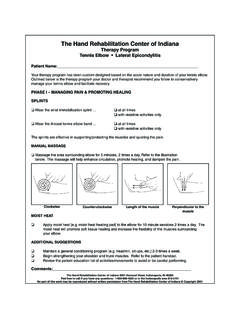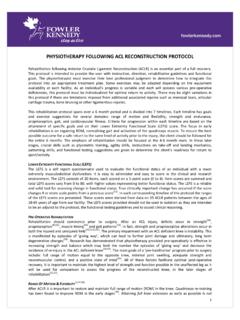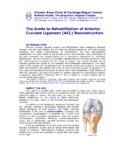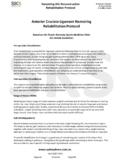Transcription of Desert Orthopedic Specialists
1 Desert Orthopedic Specialists Common Foot Procedures - Physical Therapy Guidelines 1. Hallux Rigidus: Cheilectomy with and without concomitant osteotomies. Hallux Rigidus refers to the limitation of motion of the metatarsophalangeal joint of the great toe specifically loss of Hallux dorsiflexion. Limitations occur in adults through degenerative arthritis, osteophyte proliferation and subchondral bone destruction of the first MTP joint. In adolescents Hallux Rigidus results from localized cartilage damage of the first MTP joint. As the disease progresses a dorsal osteophyte is formed on the metatarsal head presenting a mechanical abutment to Hallux dorsiflexion.
2 Indications for Cheilectomy are relief of painful impingement and restoration of 70 degrees intra-operative Hallux dorsiflexion. In grade III Hallux Rigidus concomitant osteotomies are often necessary to restore alignment and decrease articular compression of the first MTP joint (Moberg or Akin osteotomies). Moberg is a dorsal proximal phalanx closing osteotomy or an extension osteotomy of the proximal phalanx. Akin is a medial proximal phalanx closing osteotomy to correct Hallux valgus. Both are most commonly stabilized with a staple fixation and rehabilitation needs to be less aggressive. Cheilectomy Moberg Akin rehabilitation : Patients are in a compressive dressing, post-op shoe and WBAT.
3 Once incision is healed the patient is progressed to a flexible soft soled shoe to promote Hallux dorsiflexion. Physical therapy is initiated at 7-10 days s/p, 1-3x/week and anticipated suture removal 14-17 days. Protocol/Precautions: (see written protocol) Early aggressive ROM, edema control, desensitization, forefoot and FHL mobilization. Ensure restoration of normal mechanics through mobilization of seasmoids, first ray depression with Hallux dorsiflexion. Avoid varus/valgus stress to protect the surgical approach and if osteotomy preformed protect proximal phalanx stresses 4-6 weeks. Instruct patient in self ROM techniques 5-10 minutes every 2 hours.
4 Expectations are 60 degrees Hallux dorsiflexion and restoration of normal functional activities up to 3 months. 2. Interdigital Neuroma/Ganglion/Exostectomy: These procedures are straight excisions involving the affected area. Normally there are no ligamentous or tendinous structures requiring protection. Main areas to address are the hypersensitivity and edema of the affected sites. rehabilitation : Patients are in a compressive dressing, post-op shoe and WBAT. Physical Therapy is initiated at 5-7 days s/p, 1-3x/week and anticipated suture removal 14-17 days.
5 Protocol/Precautions: Emphasis is on desensitization, soft-tissue mobilization, reduction of scar formation and edema control to the entire forefoot. ROM to the toes is especially important, as they are susceptible to becoming very stiff early in post-operative period. Achilles tendon flexibility is monitored as a tight Achilles tendon increases forefoot stresses during gait. Biomechanical assessment, orthosis and shoewear assessment is necessary to help prevent further stress reactions. 3. Arthroscopic Ankle Decompression: These procedures may include but are not limited to debridement of the lateral gutter of the ankle, debridement of the sinus tarsi, debridement of anterior and posterior impingement syndromes or removal of loose bodies.
6 Complicating factors that may alter your rehabilitation approaches are associated OCD lesions, tendon tears, tendon repairs or tendon sheath releases. These lesions most commonly occur through repetitive trauma and consequently the rehabilitation program must address the biomechanical inefficiencies and restoration of normal subtalar and talocrural mobility to have the greatest outcomes. rehabilitation : Unless otherwise noted patients are WBAT, physical therapy is initiated 3-5 days s/p, 1-3x/week and anticipated suture removal 14-17 days. Protocol/Precautions: Full ankle rehabilitation without precautions excluding when concomitant procedures are preformed.
7 rehabilitation is to emphasize immediate ROM, decreasing effusion and restoration of normal biomechanics. Progression is based upon pain and effusion. Successful rehabilitation outcomes must not overlook addressing biomechanical inefficiencies, appropriate shoewear, and balance/proprioception deficiencies. 4. Weil Osteotomy, lesser toe deformities, MP Synovitis (no bunion surgeries): A Weil osteotomy is a common lesser toe deformity procedure in which the head of the metatarsal is shortened in efforts to decompress the joint. The osteotomy is stabilized with a screw fixation. Weil rehabilitation : Patients are in a compressive dressing, post-op shoe with heel down weight bearing.
8 Physical therapy is initiated at 3-5 days post-op, 1-3x/week and anticipated suture removal 14-17 days. Protocol/ rehabilitation : Emphasis is on desensitization; reduction of scar formation, soft tissue mobilization, edema control and ROM. Caution is needed if concomitant fusion or bunion procedures are performed at other joints. Lesser toe AROM only for the first 2 weeks to protect the fixation, then gentle PROM is progressed. Toe spacers are utilized for the first 4 weeks to maintain alignment. Full ankle and foot rehabilitation is commenced at 4-6 weeks post-op as tolerated. Shoe wear is resumed as tolerated and appropriately assessed (wide toe box).
9 5. Tarsal Tunnel Release/Plantar Fascia Release: Tarsal Tunnel Syndrome refers to inflammation of the posterior tibial nerve as it passes through a soft tissue tunnel behind the medial malleolus and enters the foot. Poor foot mechanics, primarily hyperpronation, or direct trauma to this area may cause increased pressure in and around the nerve. As a result, the patient usually will complain of radiating pain, numbness and/or tingling along the course of the nerve. Conservative management includes NSAID s, modalities, desensitization, soft tissue massage, ROM, stretching, strengthening, footwear modifications and orthotics.
10 Surgical management involves release of the flexor retinaculum over the tarsal as well as release of the fascia to the abductor hallucis muscle. This allows for freedom of the nerve and loss of compression. Plantar fascia release refers to the release of the medial fibers of the plantar aponeurosis and occasionally in non-athletic patients the entire aponeurosis. Even partial release may be associated with increased lateral column overload which must be addressed throughout the rehabilitation process. Not only are proper strengthening, balance and proprioception emphasized, but also shoewear and foot orthosis must be addressed.



